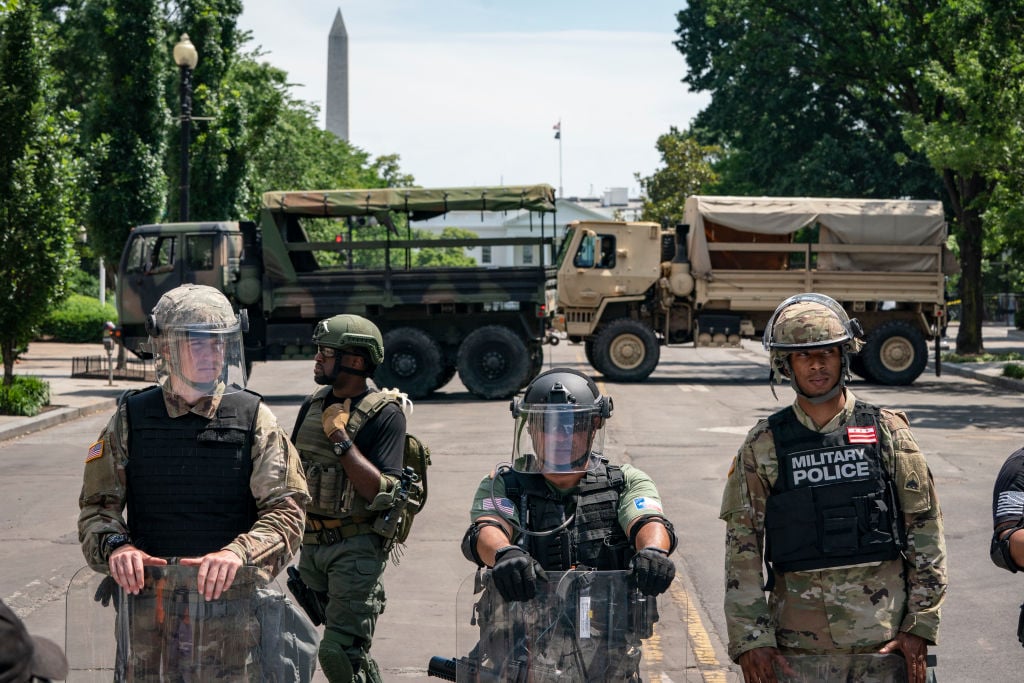Contents
For perhaps the first time in our history, ordinary Americans are worried about whether the world’s oldest democracy can actually pull off a democratic election. And plenty of political pros are worrying right along with them. We asked a bipartisan group of five experts to unspool their own specific disaster scenarios. Here’s what’s keeping each of them up at night.
The President Sends in the Troops

Rosa Brooks, professor at Georgetown Law and cofounder of the Transition Integrity Project, a bipartisan group working to prevent disruptions to the election:
By early morning on November 4, there’s no clear winner: Florida, Michigan, and North Carolina have not yet been called, though their initial returns all show Trump with what appears to be a strong lead. Trump declares victory, but Biden refuses to concede—and as the vote counting continues over the next days and weeks, Trump’s lead erodes in Michigan and Florida, where postal-service delays have created a backlog of uncounted ballots.
Seeing victory slip away, Trump’s campaign goes to court in both states in an effort to end the counting and to nullify mail-in votes already recorded. Trump tweets: “Dems have stuffed every mailbox in FL and MI with ballots from DEAD PEOPLE AND ILLEGALS. Someone should burn these fake ballots before they steal the election from REAL AMERICANS!!!”
By mid-November, thousands of protesters have poured into the streets to demand that every ballot be counted. In response, Trump calls the demands “an Antifa coup.”
On November 19, a skirmish breaks out in Tallahassee between pro-Biden protesters and armed white-nationalist groups. Several people are killed, and multiple buildings are vandalized or burned. The next day, violence and looting continue all over Florida. Several Molotov cocktails are hurled into the state capitol.

On November 21, GOP governor Ron DeSantis mobilizes Florida National Guard troops to “restore order,” and on November 22, after some prodding from the White House, he formally requests that Trump send military personnel to help law enforcement suppress what he describes as “an insurrection.” Invoking both the authority to use active-duty troops to support civil authorities and the Insurrection Act, Trump orders units of the Army’s 1st Infantry Division to deploy to Florida.
The following day, right-wing social-media posts claim that “BLM and Antifa terrorists” plan to deliver thousands of newly “harvested” fake ballots to precincts around the state. Hundreds of armed Trump supporters converge on the election precinct headquarters in heavily Democratic counties to “prevent further fraud” and demand that the counting stop. Counterprotests quickly follow. In Tallahassee, a poorly trained young National Guard soldier opens fire on the unruly crowd. Armed members of the crowd also start shooting, and by the end of the day, 35 people are dead. The precinct headquarters has been gutted by fire, and thousands of uncounted ballots have gone up in flames.
A sober Biden holds a press conference. “I call on President Trump and Governor DeSantis to withdraw all National Guard troops and active-duty military from Florida’s cities immediately,” says Biden. He calls on Americans of all party affiliations to refrain from violence and demands a new election in precincts where ballots were destroyed.
That night, soldiers from the 1st Infantry Division, who have been ordered to protect Mar-a-Lago, where Trump is now staying, open fire on a crowd of protesters outside the gates. Six demonstrators are killed.
On November 25, Trump orders more military units to Florida and directs them to “Make sure BALLOT FRAUD is STOPPED — SOMETIMES YOU NEED TO BREAK EGGS TO MAKE A BEAUTIFUL PERFECT OMLIT!!!”
The chairman of the Joint Chiefs of Staff resigns in protest. “My oath is to the Constitution, not to Donald Trump,” he writes in his resignation letter, “and I cannot continue to serve under a President who is using our Soldiers, Sailors, Airmen and Marines for partisan ends.”
“FAKE GENERAL,” Trump tweets in response. “I will replace him with a REAL MAN whose not so SKWEAMISH!”
On Thanksgiving Day, cities around the nation erupt in violence.
Back to TopDark-Arts Groups Mess With the Mail

Hal Malchow, former Democratic operative and campaign-mail expert; author of the election-theft thriller “42 Million to One”:
While Americans were fixated on funding the postal service, President Trump was pressuring his appointees to quietly mount an overhaul anyway—implementing changes designed to reduce the number of mail-in ballots. Postal executives begin shifting personnel. Post offices serving predominantly Democratic Zip codes are severely understaffed, slowing delivery. Meanwhile, Republican Zip codes are amply staffed.
Democratic organizations start their long-planned mass mailing, sending vote-by-mail applications to registered voters. By October, they complain that applications sent two weeks earlier still haven’t been delivered. In response to the outcry, a new organization, Save Your Vote, announces that Trump is trying to steal the election. To help voters, the group says, it is setting up 30,000 ballot drop boxes in battleground states. Save Your Vote will pick up and deliver ballots daily. Some Democratic leaders applaud these efforts. Meanwhile, a group of purported medical experts, the Pandemic Health Advisory, mails Democrats with a warning that says, “Voting is important, but please be careful. Millions of Americans may contract Covid-19 at polling places across America.”

Election Day arrives. Thirty states have receipt requirements for mail ballots. In other words, ballots not received by Election Day are not counted, even if they were postmarked weeks earlier. Officials in these states report a large volume of ballots that are deemed too late. In the battlegrounds of North Carolina and Nevada, a postmark can qualify a ballot—but 23,000 arrive without postmarks or the postmarks are illegible. They are not counted.
Benefiting from more than 150,000 uncounted ballots from Democratic Zip codes, Trump wins the election.
Later in November, an employee of Save Your Vote gives stunning testimony: The organization was a false-flag group, secretly funded by Trump sup-porters. Employees were directed to make daily drop-box pickups in Republican Zip codes, but during the final week before the election, in Democratic neighborhoods there was no pickup at all. It soon comes to light that the Pandemic Health Advisory, whose mailings had discouraged in-person voting, was funded by pro-Trump donors, too.
Democrats state that the election has been decided by massive fraud and file a lawsuit demanding a new election.
Back to TopForeigners Intervene—for the Democrats

Liz Mair, a Republican operative who has advised Rand Paul, Scott Walker, and Rick Perry:
I don’t think 2020 will be another Bush v. Gore. But if I’m wrong, here’s one way I could see Democrats mismanaging the chaos.
November 24, 2020: It’s been three weeks since Election Day. Absentee and mail ballots continue to trickle in. Vote tallies change by the day. Biden is narrowly ahead in multiple swing states, but litigation is ongoing in several courts. Speculation is rife that the Supreme Court will take up the case. Democratic Party elders, including some senior advisers to Biden and Harris, decide to reach out to foreign leaders to procure the “recognition” of Biden as the duly elected President. They want to try to force a resolution by showing that the international community won’t do business with President Trump past Inauguration Day.
December 10, 2020: After much behind-the-scenes lobbying, they succeed in convincing the United Nations secretary-general, the head of the World Health Organization, the president of the European Commission, Emmanuel Macron, Angela Merkel, Boris Johnson, a bunch of other “elite” European leaders, plus Justin Trudeau and Andrés Manuel López Obrador all to announce their recognition of Biden as the winner. The occasion coincides with Nobel Prize day. The leaders read a statement saying Joe Biden is “clearly” the winner, and if Trump should refuse to leave, “we will not ratify the election.”

Vladimir Putin, who seeded waves of disinformation again this year, stays silent—unable to believe his good fortune that foreign interference is being pinned on Democrats.
December 11, 2020: The Supreme Court agrees to hear Trump v. Biden.
December 14, 2020: The first poll following the world lead-ers’ endorsement, conducted by CNN, is released. The results are not good for Democrats. Seventy percent of Americans, including a substantial proportion of self-described Biden-Harris voters, indicate that they view the action by foreign leaders as unjustifiable interference in our electoral process. In particular, polling shows that suburban, Trump-skeptical women who went for Biden are second-guessing their votes, and a majority say that if they could recast their ballots, they would in fact go for Trump.
Over the next week: Republican Supreme Court whisperers argue behind the scenes that justices Neil Gorsuch and Brett Kavanaugh must show their loyalty to the man who appointed them. Privately, Trump is counting on it. Chief Justice John Roberts concludes that his vote will be critical. He is inclined to rule in a way that ensures stability, as he has done throughout the Trump era, but that also preserves the court’s authority with the public. The justices agree to hear oral arguments: The 2020 election hinges on the vote of the chief justice.
Back to TopEarly Voting, Early Chaos

Sylvia Albert, director of voting and elections at Common Cause, the nonpartisan public-interest group:
September 24: Early voting is under way in nine states, including Illinois and Virginia. Both states experience an immediate problem: The electronic pollbooks that store all voter data in the polling place have labeled every voter as requesting an absentee ballot.
September 25: Technicians have discovered a fatal coding error in the e-pollbooks. The equipment must be returned to the vendor for reprogramming.
September 26: Secretaries of State hold an emergency meeting—due to the pandemic, early voting is essential, and the same e-pollbook technology is set to be used in 11 additional states.
September 27–October 14: E-pollbooks nationwide are sent back. Voters in the affected areas use paper ballots, which quickly run out. To cope, early-voting hours are cut or eliminated in many states, and people are told to return at a later date.
Conspiracy theories proliferate. Partisans claim to have uncovered a “deep state” plot to steal the election. Technicians working on recalibrating the equipment are receiving death threats and being doxed.

October 15–October 21: Without any technology, elections officials scramble and manage to acquire more paper ballots.
October 21–November 2: The reprogrammed e-pollbooks are rolling back into communities. But an insider has leaked the truck routes, and angry protesters attempt to block their arrival. Several trucks are forced off the road, and devices are damaged.
November 3: On Election Day, because of the equipment chaos, there are fewer places to vote. Officials are overwhelmed by the turnout, with those who couldn’t vote early adding to the crowds. Common issues such as machine glitches, paper jams, and staff shortages are now compounded. Lines in communities affected by the initial programming error become miles long. Some voters leave out of exhaustion, others for fear of contracting Covid-19.
Tens of thousands of voters now face the prospect of being disenfranchised.
Voting-rights advocates and lawyers in DC swing into action, urging states to extend voting by three hours. Nine states rise to the call and extend polling. But Ohio and Florida refuse.
Celebrities rally to the cause on social media—Ohioans LeBron James, Martin Sheen, and Halle Berry lead a pressure campaign, causing Ohio to relent. Florida, though, resists a similar effort. Advocates file suit, and a court finally tells the state it must keep the polls open.
November 4–10: Election workers tally votes nationwide for a week straight.
November 10: The final state certifies its election results, and the winner of the presidential election is named.
Back to TopA New Disinformation Weapon: Small Numbers

Raffi Krikorian, managing director at the Emerson Collective and former chief technology officer of the Democratic National Committee:
Trust is the most important ingredient in any election—and the most delicate. Much of that trust hinges on small details being accurate. This is especially true of voter registries, the databases of personal information that allow people to vote by mail and in person. A number of minute errors could accumulate, going from a small burn to a wild blaze—and leaving it unclear whether the crisis amounted to a hack or merely an error.
Imagine that it’s October and a Michigan postman notices that Mr. Johnson’s ballot is misaddressed to his next-door neighbor. Being friendly, the mailman simply puts the ballot in Mr. Johnson’s mailbox instead. In Pennsylvania, something similar is happening: An Allegheny County elections office is receiving calls from people who never received ballots—and a few are calling to say they received someone else’s.
Fast-forward to Election Day: In Milwaukee, there are voters such as Ms. Smith, of 4321 Main Street, who show up to vote with driver’s license in hand. A poll worker checks the registration book and sees that Smith is listed at 4322 Main Street—the house next door. Unable to let her vote, the worker hands her a provisional ballot.

Reporters start to notice a refrain across social media—people complaining that they were turned away from their polls because of an error. Anecdotally, it also appears many mail voters haven’t received their ballots and are confused. #ICouldntVote starts to trend. Soon the hashtag dominates cable news.
Democratic data analysts start to rip through voter files, as well as historical “snapshots,” trying to understand what’s going on. One analyst in Chicago notices that over the summer, a small number of voters’ addresses nationwide seemed to change—all by one digit. It’s as if these voters all decided to pick up and move next door. The analysts are worried, and they notify the Biden campaign.
Biden officials don’t know what to make of the discovery. Somebody on the data team utters the word “hack” without knowing for sure. That word spreads as the campaign starts calling Secretaries of State. In one of the meetings, a staffer sneaks a phone out of his pocket and texts a reporter. Now the TV networks are asking, “Could this election have been hacked?” Republicans seize on the news and blanket the airwaves, questioning all mail-in ballots.
Late on Election Night, panicked Secretaries of States and election commissioners are frantically strategizing. They’re not equipped to do any rapid analysis of their voter files, given the antiquated nature of their technology. They debate whether the news is true and what it means for the votes currently being tallied.
By midnight, President Trump tweets that the election has been rigged and points to videos from CNN as well as tweets from the New York Times, which are desperately trying to decipher what’s happening. Before the results are even announced, national trust in the election is poisoned.
Photograph of Brooks by Jody McKitrick. All other headshots courtesy of subjects.
This article appears in the October 2020 issue of Washingtonian.








